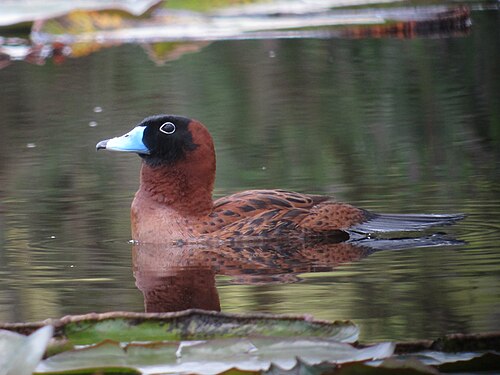Masked duck
| Masked duck | |
|---|---|

| |
| Adult males,Tobago | |
| Scientific classification | |
| Domain: | Eukaryota |
| Kingdom: | Animalia |
| Phylum: | Chordata |
| Class: | Aves |
| Order: | Anseriformes |
| Family: | Anatidae |
| Genus: | Nomonyx Ridgway,1880 |
| Species: | N. dominicus
|
| Binomial name | |
| Nomonyx dominicus (Linnaeus,1766)
| |

| |
| Synonyms | |
| |
Themasked duck(Nomonyx dominicus) is a tinystiff-tailed duckranging through thetropicalAmericas.
Taxonomy
[edit]The only member of thegenusNomonyx,it is intermediate between the rather primitiveblack-headed duck(Heteronetta) and the veryapomorphictrue stiff-tailed ducks. It is sometimes included with the latter in the genusOxyura,but the masked ducks are now considered the descendants of amissing linkin theOxyurinievolution, having changed little for millions of years.[2][3]
Distribution and habitat
[edit]They are found from southernTexasandMexicotoSouth Americaand also in theCaribbean.Primarily notmigratory,masked ducks are reported as very uncommon vagrants in the southernmostUnited States,along the Mexican border and inFlorida.As of 2000, the conservation status for masked ducks in Texas is 3,800 birds.[4]On April 1, 1962, it was recorded fromLowndes County, Georgia,where it was photographed byAlexander Wetmore.[5]Masked ducks breed in any freshwater body withmarshvegetation and surrounded by heavy tree cover. They also occur inmangroveswamps.
-
Male
-
Female
Description
[edit]Breedingadult males have a rust-colored body with a black face and mottled wings. Adult females, winter males, andjuvenileshave a barred brownish gray body, with two horizontal, dark-colored stripes running through the buff-colored face.
Diet
[edit]These ducks mainly feed onseeds,roots, stems,[6]and leaves of aquaticplants.They also eat aquaticinsectsandcrustaceans.They feed by diving. These ducks are usually very secretive, but they are not rare and not considered threatened by theIUCN.[1]
References
[edit]- ^abBirdLife International (2021)."Nomonyx dominicus".IUCN Red List of Threatened Species.2021:e.T22679789A137758280.Retrieved7 March2023.
- ^Livezey, Bradley C. (1986)."A phylogenetic analysis of recent anseriform genera using morphological characters"(PDF).Auk.103(4): 737–754.doi:10.1093/auk/103.4.737.
- ^McCracken, Kevin G.; Harshman, John; McClellan, David A. & Afton, Alan D. (1999)."Data set incongruence and correlated character evolution: An example of functional convergence in the hind-limbs of stifftail diving ducks".Systematic Biology.48(4): 683–714.doi:10.1080/106351599259979.PMID12066296.
- ^Jack Eitniear (2000)."Masked duck".The Texas Breeding Bird Atlas.RetrievedMarch 28,2015.
- ^"Masked Duck,Nomonyx dominicus".River Basin Center/University of Georgia.Archived fromthe originalon April 2, 2015.RetrievedMarch 28,2015.
- ^"Nomonyx dominicus(Masked Duck) "(PDF).The Online Guide to the Animals of Trinidad and Tobago.UWI.
Further reading
[edit]- del Hoyo, Josep; Elliott, Andrew & Sargatal, Jordi (eds.) (1992):Handbook of Birds of the World(Volume 1: Ostrich to Ducks). Lynx Edicions, Barcelona.ISBN84-87334-10-5
- National Geographic Society(2002):Field Guide to the Birds of North America.National Geographic,Washington DC.ISBN0-7922-6877-6
- Sibley, David Allen(2000):The Sibley Guide to Birds.Alfred A. Knopf,New York.ISBN0-679-45122-6






